Unit 4 Where’s my backpack ?[上学期]
文档属性
| 名称 | Unit 4 Where’s my backpack ?[上学期] | 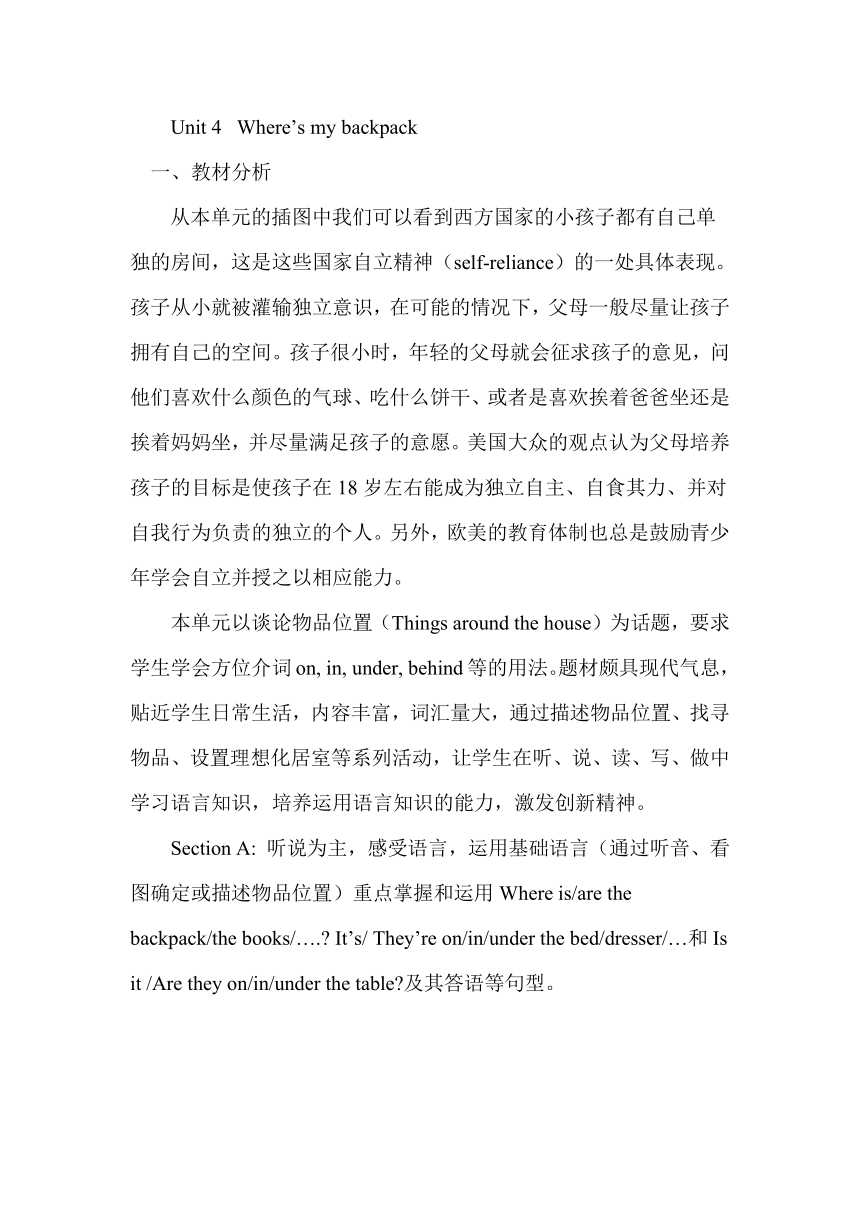 | |
| 格式 | rar | ||
| 文件大小 | 13.7KB | ||
| 资源类型 | 教案 | ||
| 版本资源 | 人教新目标(Go for it)版 | ||
| 科目 | 英语 | ||
| 更新时间 | 2006-12-05 21:53:00 | ||
图片预览

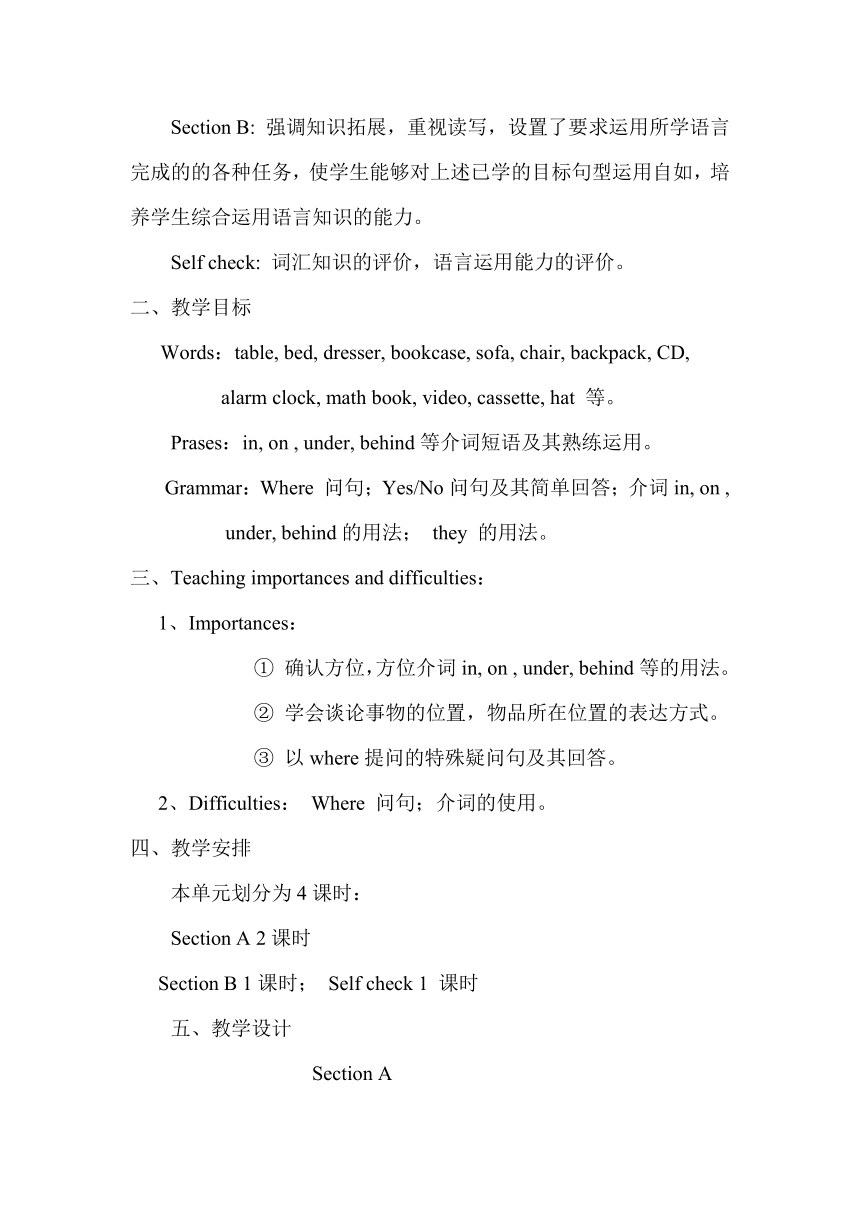
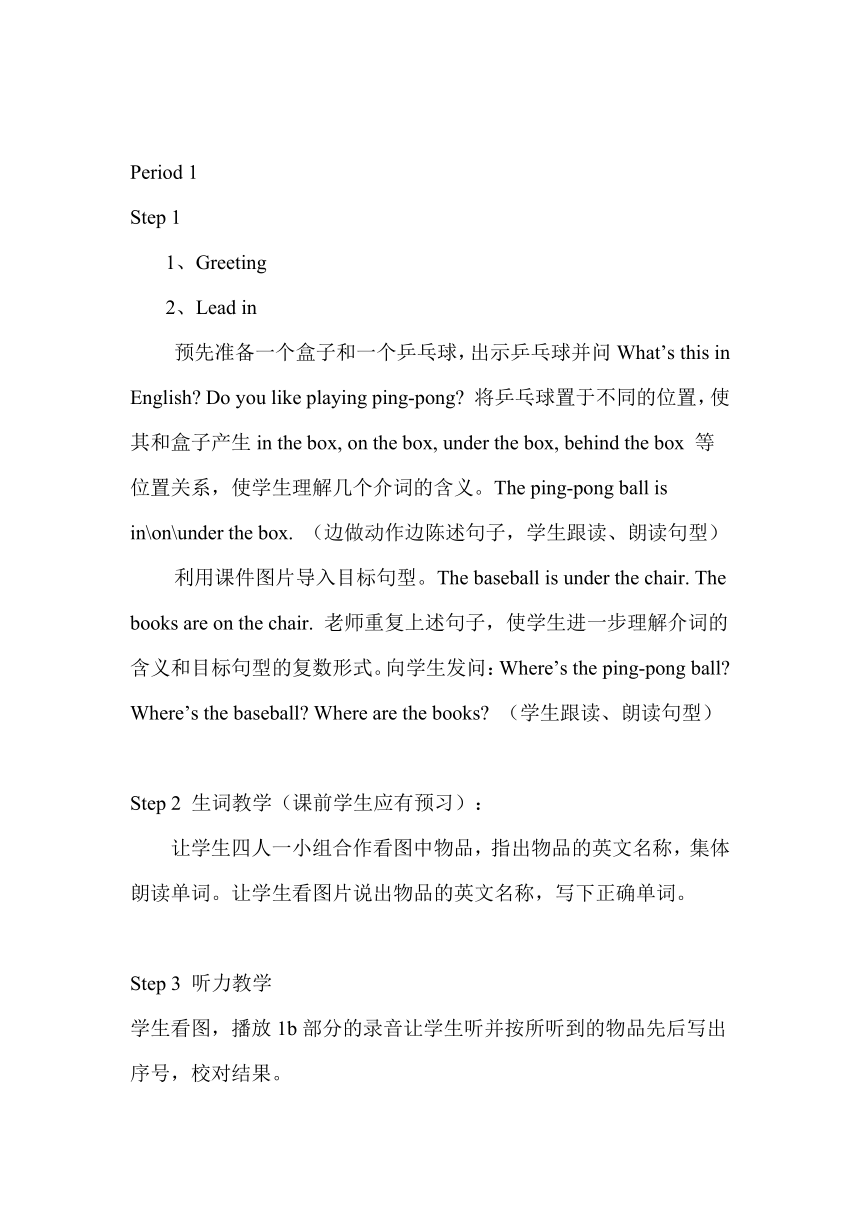
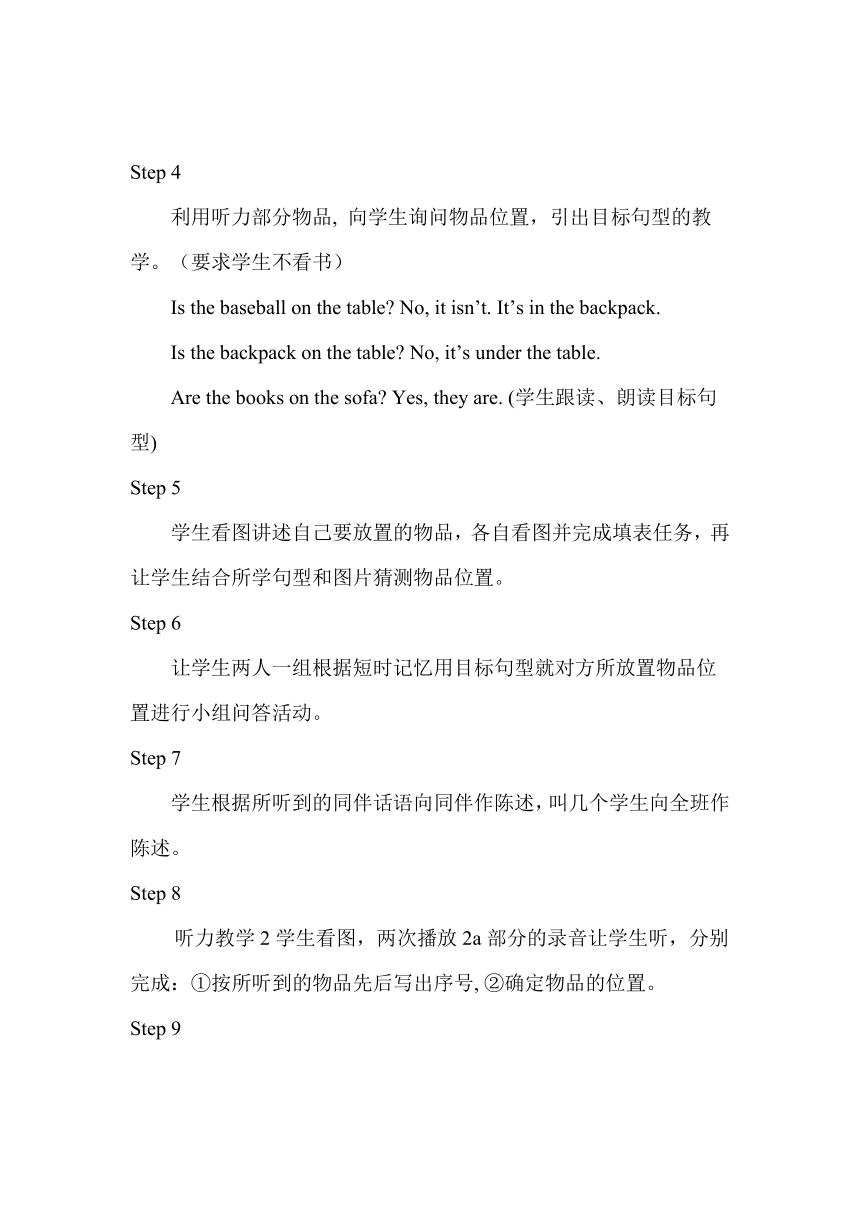
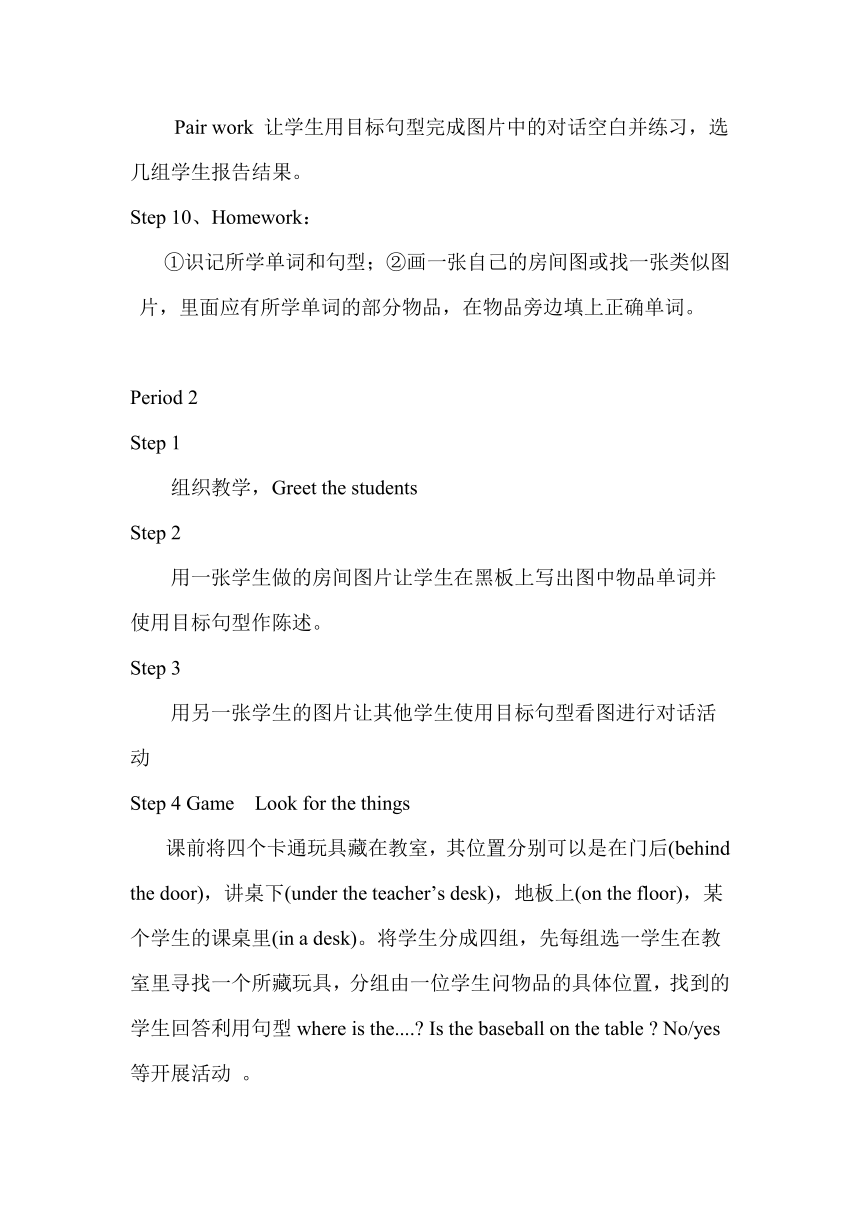
文档简介
Unit 4 Where’s my backpack
一、教材分析
从本单元的插图中我们可以看到西方国家的小孩子都有自己单独的房间,这是这些国家自立精神(self-reliance)的一处具体表现。孩子从小就被灌输独立意识,在可能的情况下,父母一般尽量让孩子拥有自己的空间。孩子很小时,年轻的父母就会征求孩子的意见,问他们喜欢什么颜色的气球、吃什么饼干、或者是喜欢挨着爸爸坐还是挨着妈妈坐,并尽量满足孩子的意愿。美国大众的观点认为父母培养孩子的目标是使孩子在18岁左右能成为独立自主、自食其力、并对自我行为负责的独立的个人。另外,欧美的教育体制也总是鼓励青少年学会自立并授之以相应能力。
本单元以谈论物品位置(Things around the house)为话题,要求学生学会方位介词on, in, under, behind等的用法。题材颇具现代气息,贴近学生日常生活,内容丰富,词汇量大,通过描述物品位置、找寻物品、设置理想化居室等系列活动,让学生在听、说、读、写、做中学习语言知识,培养运用语言知识的能力,激发创新精神。
Section A: 听说为主,感受语言,运用基础语言(通过听音、看图确定或描述物品位置)重点掌握和运用Where is/are the backpack/the books/…. It’s/ They’re on/in/under the bed/dresser/…和Is it /Are they on/in/under the table 及其答语等句型。
Section B: 强调知识拓展,重视读写,设置了要求运用所学语言完成的的各种任务,使学生能够对上述已学的目标句型运用自如,培养学生综合运用语言知识的能力。
Self check: 词汇知识的评价,语言运用能力的评价。
二、教学目标
Words:table, bed, dresser, bookcase, sofa, chair, backpack, CD, alarm clock, math book, video, cassette, hat 等。
Prases:in, on , under, behind等介词短语及其熟练运用。
Grammar:Where 问句;Yes/No问句及其简单回答;介词in, on , under, behind的用法; they 的用法。
三、Teaching importances and difficulties:
1、Importances:
① 确认方位,方位介词in, on , under, behind等的用法。
② 学会谈论事物的位置,物品所在位置的表达方式。
③ 以where提问的特殊疑问句及其回答。
2、Difficulties: Where 问句;介词的使用。
四、教学安排
本单元划分为4课时:
Section A 2课时
Section B 1课时; Self check 1 课时
五、教学设计
Section A
Period 1
Step 1
1、Greeting
2、Lead in
预先准备一个盒子和一个乒乓球,出示乒乓球并问What’s this in English Do you like playing ping-pong 将乒乓球置于不同的位置,使其和盒子产生in the box, on the box, under the box, behind the box 等位置关系,使学生理解几个介词的含义。The ping-pong ball is in\on\under the box. (边做动作边陈述句子,学生跟读、朗读句型)
利用课件图片导入目标句型。The baseball is under the chair. The books are on the chair. 老师重复上述句子,使学生进一步理解介词的含义和目标句型的复数形式。向学生发问:Where’s the ping-pong ball Where’s the baseball Where are the books (学生跟读、朗读句型)
Step 2 生词教学(课前学生应有预习):
让学生四人一小组合作看图中物品,指出物品的英文名称,集体朗读单词。让学生看图片说出物品的英文名称,写下正确单词。
Step 3 听力教学
学生看图,播放1b部分的录音让学生听并按所听到的物品先后写出序号,校对结果。
Step 4
利用听力部分物品, 向学生询问物品位置,引出目标句型的教学。(要求学生不看书)
Is the baseball on the table No, it isn’t. It’s in the backpack.
Is the backpack on the table No, it’s under the table.
Are the books on the sofa Yes, they are. (学生跟读、朗读目标句型)
Step 5
学生看图讲述自己要放置的物品,各自看图并完成填表任务,再让学生结合所学句型和图片猜测物品位置。
Step 6
让学生两人一组根据短时记忆用目标句型就对方所放置物品位置进行小组问答活动。
Step 7
学生根据所听到的同伴话语向同伴作陈述,叫几个学生向全班作陈述。
Step 8
听力教学2学生看图,两次播放2a部分的录音让学生听,分别完成:①按所听到的物品先后写出序号, ②确定物品的位置。
Step 9
Pair work 让学生用目标句型完成图片中的对话空白并练习,选几组学生报告结果。
Step 10、Homework:
①识记所学单词和句型;②画一张自己的房间图或找一张类似图片,里面应有所学单词的部分物品,在物品旁边填上正确单词。
Period 2
Step 1
组织教学,Greet the students
Step 2
用一张学生做的房间图片让学生在黑板上写出图中物品单词并使用目标句型作陈述。
Step 3
用另一张学生的图片让其他学生使用目标句型看图进行对话活动
Step 4 Game Look for the things
课前将四个卡通玩具藏在教室,其位置分别可以是在门后(behind the door),讲桌下(under the teacher’s desk),地板上(on the floor),某个学生的课桌里(in a desk)。将学生分成四组,先每组选一学生在教室里寻找一个所藏玩具,分组由一位学生问物品的具体位置,找到的学生回答利用句型where is the.... Is the baseball on the table No/yes等开展活动 。
Step 5书面练习
仔细观察下列句子,学生独立分析各个句子的特征,作总结。
① The eraser is in the pencil-box.
② The desks are in the classroom.
③ The books are in the bookcase.
④ The picture is on the wall.
⑤ The balls are under the sofa.
Step 6
总结语言知识 让学生二人或四人小组观察、分析Grammar Focus 里的句型特征,并作汇报,讨论并写出Yes\No 问答句的特征
Step 7
3a、3b部分教学 让学生阅读并排成正确的对话,完成任务后练习图中对话。
Step 8
3c部分对话活动 小组练习,选几组学生看图片问答。
Step 9 Game Find the difference
让学生二人一组仔细观察图片,找出差别之处,并进行问答活动。
Step 10 Homework
1、复习识记Section A部分词汇和句型
2、预习Section B 部分词汇
3 完成下面书面练习
⑴ Form sentences
① where, the, sofa, is ___________________________
② under, it, is, the, table__________________________
③ my, pen, pencil, where, are, and______________________________
④ backpack, are, in, they, my_________________________________
⑤ baseball, is, my, under, the, bed_______________________________
⑥ your, under, your, ID, card, is, bed____________________________
⑵ Number (from 1 to 5) the sentences to make a conversation.
Monica: ______ “No, it isn’t in my backpack.”
James: ______ “Oh! It’s in my backpack.”
Monica: ______ “So, where’s my bat ”
James: _______ “ It’s in your backpack.”
Monica: ______ “ Where’s my baseball ”
⑶ Fill in the blanks with these words.(多选)
under, on, next to, in, in front of, behind
① Where’s the ruler It’s __________the pencil-case.
② Is the telephone behind the pencil-case
No, it’s ______ the pencil-case.
③ Are the papers _______the pencil-case Yes, they are.
④ Where are the books They are ________ the telephone.
⑤ Where’s the orange It’s ________ the pencil-case.
Period 3 Section B
教学目的:
拓展知识,重视读写,运用所学语言完成的的各种任务,使学生熟练运用Section A中已学的目标句型,培养学生综合运用语言知识的能力。
教学过程:
一、创设情景,导入新课
1、复习前一部分所学的单词和物品位置的描述。(What’s this in English Where is it Is it on the bed etc. What is on the table )
Guessing Game. Let the students guess where the backpack /baseball is and what is on the table.(Task 1)
2、学习math book等物品名称。 (One day Tommy asks his good friend Dale to his house. Tommy has many things in his room. What does he see Please look at his room .What’s this in English … )
3、词汇记忆竞赛:( There are so many things in the room. Can you remember all of them Let’s have a memory competition.)
Let’s see who will win!
(Task2 Look at Tommy’s room for 3 minutes . and write down all the things you remember.)
二、多边互动,学习探究
1、引导学生进行Pairwork活动,根据示例谈论1a部分所提到的活动,正确使用所学where句型。( Congratulation to the winner! The next day Dale tells his classmates something about Tommy’s room. Everyone wants to know more about it. They are asking Tommy a lot of questions. Now suppose you were Tommy/Dale, you answer your partner’s questions .)
(Task3 Pair work Ask and answer. A: Where’s notebook
B: It’s on the bed.)
2、播放2a部分的录音,引导学生一边听录音,一边勾出所听到的物品名称. (Suddenly Tommy remembers he has left many things at home. He has to make a telephone to his mother. Now let’s listen and try to find what the things Tommy wants from his home.)
(Task4 Listen and circle the things Tommy wants from his room.)
3、播放2b部分的录音,写出句子。(Oh , Tommy’s mom can’t find a pen to write them down. Would you please help her )
(Task5 Listen and write down where Tommy’s thing are.)
4、引导学生阅读3a部分的短文,要求学生画出文中的物品名称并理解其含义 (But Tommy’s mother isn’t at home. She has to write a note and send it to her daughter Sally by e-mail to help her. Where are the things in the picture Let’s read the note and draw the missing things in the picture.)
(Task6 Read the note and draw the missing things in the picture.)
5、引导学生先看图,再填空。(Tommy gets the things with Sally’s help. Two days later, he gets a note from his sister Sally. She asks him to bring some things to school. He feels a little difficult because some words are missing in the note. Can you help him Let’s look at the picture and fill in the blanks)
(Task7 Look at the picture and fill in the blanks)
6、Pair work ,引导学生写出自己房间里所拥有的物品及所在位置,注意使用名词的单复数形式。(You’re great. Well done. From these pictures we can see many things in Tommy’s and Sally’s rooms. Do you have many things in your room Can you tell me where they are Please write a note asking for four/five things from your room.)
(Task8 Write a note asking for four/five things from his/her room.)
三、合作交流,巩固提高
引导学生进行Group work活动,设计新居,让学生描述各个家具的摆放,巩固介词的用法。
( OK. There are many things in your room. Do you want a nicer room What kind of room would you like What things would you like to have Please draw your ideal room and describe it to your classmates.)
Now here are some beautiful rooms . Do you want one like these How can you get one (Task 9 Draw an ideal room and describe it to his/her classmates.)
任务名称:An ideal room
活动形式:四人一组
操作过程:教师提供卧室简图一幅。
1、物色需要的物品。
2、合作画出理想的房间。
3、作品展示。小组讨论后,推选一人为代表,用英语描述理想的房间。
如:Here is my ideal room. My bed is ……There are some books……
活动评价:画面精美,有创意,而且描述无误当场给予奖励。
Homework看图写话(任选一题)
1、Mike’s bedroom (描述Mike的卧室中的物品及所在的位置。)
2、Write a short passage by using the following things.(用所给的物品写一篇小短文,说明摆放的位置)
Period 4 Self check
教学目的:
通过学生对词汇知识和语言运用能力的评价,调整学习方法,使他们形成自己的学习风格和学习策略,提高学习效率。
教学过程:
一、创设情景,导入新课
1引导学生以自己的方式放置下列事物,然后做一个小报告。(What’s this in English It’s a….Where would you like to put them Please put the things in order in your own way and then report it to the class.)
2 引导学生进行Just for fun!游戏活动,复习、巩固所学的Where’s…. It’s…., Is it….. Yes, it is. No, it isn’t等句型和语法知识。
操作过程:
1)、教师用布将一位学生的眼睛蒙上,另一学生然后迅速藏好某件物品。
2)、请蒙上眼睛的同学用“Is it in /under/behind/on… Are they next to …?”等句型猜测所藏物品的具体位置,限猜三次。
3)、其他学生根据实际情况做出Yes/No的回答
活动评价:猜对了就成功。
二、学习探究,合作交流。
1、引导学生根据Note内容画出图画。(Well done. But here is a note from Eric. Please read it and draw the room.)
2、指导学生根据图片进行写作训练。(Ann is looking for a room. Here is a picture of the room she needs. Please help her write a notice.)
Notice
Looking for: A room
I need a room like this:
There is a sofa in the room .________________
__________________________________________
__________________________________________
Please call Ann at 862-6598
三、自我检测,巩固提高
1、引导学生进行关键词自我检测,完成自我评估,复习所学的重点词汇。
We have learned all these words in this unit. Can you remember all the words
Read the words and check the words you know and write the Chinese meaning down. Now please check yourself. Let’s find out who remembers most.
2、引导学生在筑词表上进行筑词活动,引导学生采用各种有效途径记忆单词,为以后的进一步学习提供保障。
How many new words do you learn and remember in this unit but not in the book
Who learns and remembers the most new words in our class
Congratulations!
一、教材分析
从本单元的插图中我们可以看到西方国家的小孩子都有自己单独的房间,这是这些国家自立精神(self-reliance)的一处具体表现。孩子从小就被灌输独立意识,在可能的情况下,父母一般尽量让孩子拥有自己的空间。孩子很小时,年轻的父母就会征求孩子的意见,问他们喜欢什么颜色的气球、吃什么饼干、或者是喜欢挨着爸爸坐还是挨着妈妈坐,并尽量满足孩子的意愿。美国大众的观点认为父母培养孩子的目标是使孩子在18岁左右能成为独立自主、自食其力、并对自我行为负责的独立的个人。另外,欧美的教育体制也总是鼓励青少年学会自立并授之以相应能力。
本单元以谈论物品位置(Things around the house)为话题,要求学生学会方位介词on, in, under, behind等的用法。题材颇具现代气息,贴近学生日常生活,内容丰富,词汇量大,通过描述物品位置、找寻物品、设置理想化居室等系列活动,让学生在听、说、读、写、做中学习语言知识,培养运用语言知识的能力,激发创新精神。
Section A: 听说为主,感受语言,运用基础语言(通过听音、看图确定或描述物品位置)重点掌握和运用Where is/are the backpack/the books/…. It’s/ They’re on/in/under the bed/dresser/…和Is it /Are they on/in/under the table 及其答语等句型。
Section B: 强调知识拓展,重视读写,设置了要求运用所学语言完成的的各种任务,使学生能够对上述已学的目标句型运用自如,培养学生综合运用语言知识的能力。
Self check: 词汇知识的评价,语言运用能力的评价。
二、教学目标
Words:table, bed, dresser, bookcase, sofa, chair, backpack, CD, alarm clock, math book, video, cassette, hat 等。
Prases:in, on , under, behind等介词短语及其熟练运用。
Grammar:Where 问句;Yes/No问句及其简单回答;介词in, on , under, behind的用法; they 的用法。
三、Teaching importances and difficulties:
1、Importances:
① 确认方位,方位介词in, on , under, behind等的用法。
② 学会谈论事物的位置,物品所在位置的表达方式。
③ 以where提问的特殊疑问句及其回答。
2、Difficulties: Where 问句;介词的使用。
四、教学安排
本单元划分为4课时:
Section A 2课时
Section B 1课时; Self check 1 课时
五、教学设计
Section A
Period 1
Step 1
1、Greeting
2、Lead in
预先准备一个盒子和一个乒乓球,出示乒乓球并问What’s this in English Do you like playing ping-pong 将乒乓球置于不同的位置,使其和盒子产生in the box, on the box, under the box, behind the box 等位置关系,使学生理解几个介词的含义。The ping-pong ball is in\on\under the box. (边做动作边陈述句子,学生跟读、朗读句型)
利用课件图片导入目标句型。The baseball is under the chair. The books are on the chair. 老师重复上述句子,使学生进一步理解介词的含义和目标句型的复数形式。向学生发问:Where’s the ping-pong ball Where’s the baseball Where are the books (学生跟读、朗读句型)
Step 2 生词教学(课前学生应有预习):
让学生四人一小组合作看图中物品,指出物品的英文名称,集体朗读单词。让学生看图片说出物品的英文名称,写下正确单词。
Step 3 听力教学
学生看图,播放1b部分的录音让学生听并按所听到的物品先后写出序号,校对结果。
Step 4
利用听力部分物品, 向学生询问物品位置,引出目标句型的教学。(要求学生不看书)
Is the baseball on the table No, it isn’t. It’s in the backpack.
Is the backpack on the table No, it’s under the table.
Are the books on the sofa Yes, they are. (学生跟读、朗读目标句型)
Step 5
学生看图讲述自己要放置的物品,各自看图并完成填表任务,再让学生结合所学句型和图片猜测物品位置。
Step 6
让学生两人一组根据短时记忆用目标句型就对方所放置物品位置进行小组问答活动。
Step 7
学生根据所听到的同伴话语向同伴作陈述,叫几个学生向全班作陈述。
Step 8
听力教学2学生看图,两次播放2a部分的录音让学生听,分别完成:①按所听到的物品先后写出序号, ②确定物品的位置。
Step 9
Pair work 让学生用目标句型完成图片中的对话空白并练习,选几组学生报告结果。
Step 10、Homework:
①识记所学单词和句型;②画一张自己的房间图或找一张类似图片,里面应有所学单词的部分物品,在物品旁边填上正确单词。
Period 2
Step 1
组织教学,Greet the students
Step 2
用一张学生做的房间图片让学生在黑板上写出图中物品单词并使用目标句型作陈述。
Step 3
用另一张学生的图片让其他学生使用目标句型看图进行对话活动
Step 4 Game Look for the things
课前将四个卡通玩具藏在教室,其位置分别可以是在门后(behind the door),讲桌下(under the teacher’s desk),地板上(on the floor),某个学生的课桌里(in a desk)。将学生分成四组,先每组选一学生在教室里寻找一个所藏玩具,分组由一位学生问物品的具体位置,找到的学生回答利用句型where is the.... Is the baseball on the table No/yes等开展活动 。
Step 5书面练习
仔细观察下列句子,学生独立分析各个句子的特征,作总结。
① The eraser is in the pencil-box.
② The desks are in the classroom.
③ The books are in the bookcase.
④ The picture is on the wall.
⑤ The balls are under the sofa.
Step 6
总结语言知识 让学生二人或四人小组观察、分析Grammar Focus 里的句型特征,并作汇报,讨论并写出Yes\No 问答句的特征
Step 7
3a、3b部分教学 让学生阅读并排成正确的对话,完成任务后练习图中对话。
Step 8
3c部分对话活动 小组练习,选几组学生看图片问答。
Step 9 Game Find the difference
让学生二人一组仔细观察图片,找出差别之处,并进行问答活动。
Step 10 Homework
1、复习识记Section A部分词汇和句型
2、预习Section B 部分词汇
3 完成下面书面练习
⑴ Form sentences
① where, the, sofa, is ___________________________
② under, it, is, the, table__________________________
③ my, pen, pencil, where, are, and______________________________
④ backpack, are, in, they, my_________________________________
⑤ baseball, is, my, under, the, bed_______________________________
⑥ your, under, your, ID, card, is, bed____________________________
⑵ Number (from 1 to 5) the sentences to make a conversation.
Monica: ______ “No, it isn’t in my backpack.”
James: ______ “Oh! It’s in my backpack.”
Monica: ______ “So, where’s my bat ”
James: _______ “ It’s in your backpack.”
Monica: ______ “ Where’s my baseball ”
⑶ Fill in the blanks with these words.(多选)
under, on, next to, in, in front of, behind
① Where’s the ruler It’s __________the pencil-case.
② Is the telephone behind the pencil-case
No, it’s ______ the pencil-case.
③ Are the papers _______the pencil-case Yes, they are.
④ Where are the books They are ________ the telephone.
⑤ Where’s the orange It’s ________ the pencil-case.
Period 3 Section B
教学目的:
拓展知识,重视读写,运用所学语言完成的的各种任务,使学生熟练运用Section A中已学的目标句型,培养学生综合运用语言知识的能力。
教学过程:
一、创设情景,导入新课
1、复习前一部分所学的单词和物品位置的描述。(What’s this in English Where is it Is it on the bed etc. What is on the table )
Guessing Game. Let the students guess where the backpack /baseball is and what is on the table.(Task 1)
2、学习math book等物品名称。 (One day Tommy asks his good friend Dale to his house. Tommy has many things in his room. What does he see Please look at his room .What’s this in English … )
3、词汇记忆竞赛:( There are so many things in the room. Can you remember all of them Let’s have a memory competition.)
Let’s see who will win!
(Task2 Look at Tommy’s room for 3 minutes . and write down all the things you remember.)
二、多边互动,学习探究
1、引导学生进行Pairwork活动,根据示例谈论1a部分所提到的活动,正确使用所学where句型。( Congratulation to the winner! The next day Dale tells his classmates something about Tommy’s room. Everyone wants to know more about it. They are asking Tommy a lot of questions. Now suppose you were Tommy/Dale, you answer your partner’s questions .)
(Task3 Pair work Ask and answer. A: Where’s notebook
B: It’s on the bed.)
2、播放2a部分的录音,引导学生一边听录音,一边勾出所听到的物品名称. (Suddenly Tommy remembers he has left many things at home. He has to make a telephone to his mother. Now let’s listen and try to find what the things Tommy wants from his home.)
(Task4 Listen and circle the things Tommy wants from his room.)
3、播放2b部分的录音,写出句子。(Oh , Tommy’s mom can’t find a pen to write them down. Would you please help her )
(Task5 Listen and write down where Tommy’s thing are.)
4、引导学生阅读3a部分的短文,要求学生画出文中的物品名称并理解其含义 (But Tommy’s mother isn’t at home. She has to write a note and send it to her daughter Sally by e-mail to help her. Where are the things in the picture Let’s read the note and draw the missing things in the picture.)
(Task6 Read the note and draw the missing things in the picture.)
5、引导学生先看图,再填空。(Tommy gets the things with Sally’s help. Two days later, he gets a note from his sister Sally. She asks him to bring some things to school. He feels a little difficult because some words are missing in the note. Can you help him Let’s look at the picture and fill in the blanks)
(Task7 Look at the picture and fill in the blanks)
6、Pair work ,引导学生写出自己房间里所拥有的物品及所在位置,注意使用名词的单复数形式。(You’re great. Well done. From these pictures we can see many things in Tommy’s and Sally’s rooms. Do you have many things in your room Can you tell me where they are Please write a note asking for four/five things from your room.)
(Task8 Write a note asking for four/five things from his/her room.)
三、合作交流,巩固提高
引导学生进行Group work活动,设计新居,让学生描述各个家具的摆放,巩固介词的用法。
( OK. There are many things in your room. Do you want a nicer room What kind of room would you like What things would you like to have Please draw your ideal room and describe it to your classmates.)
Now here are some beautiful rooms . Do you want one like these How can you get one (Task 9 Draw an ideal room and describe it to his/her classmates.)
任务名称:An ideal room
活动形式:四人一组
操作过程:教师提供卧室简图一幅。
1、物色需要的物品。
2、合作画出理想的房间。
3、作品展示。小组讨论后,推选一人为代表,用英语描述理想的房间。
如:Here is my ideal room. My bed is ……There are some books……
活动评价:画面精美,有创意,而且描述无误当场给予奖励。
Homework看图写话(任选一题)
1、Mike’s bedroom (描述Mike的卧室中的物品及所在的位置。)
2、Write a short passage by using the following things.(用所给的物品写一篇小短文,说明摆放的位置)
Period 4 Self check
教学目的:
通过学生对词汇知识和语言运用能力的评价,调整学习方法,使他们形成自己的学习风格和学习策略,提高学习效率。
教学过程:
一、创设情景,导入新课
1引导学生以自己的方式放置下列事物,然后做一个小报告。(What’s this in English It’s a….Where would you like to put them Please put the things in order in your own way and then report it to the class.)
2 引导学生进行Just for fun!游戏活动,复习、巩固所学的Where’s…. It’s…., Is it….. Yes, it is. No, it isn’t等句型和语法知识。
操作过程:
1)、教师用布将一位学生的眼睛蒙上,另一学生然后迅速藏好某件物品。
2)、请蒙上眼睛的同学用“Is it in /under/behind/on… Are they next to …?”等句型猜测所藏物品的具体位置,限猜三次。
3)、其他学生根据实际情况做出Yes/No的回答
活动评价:猜对了就成功。
二、学习探究,合作交流。
1、引导学生根据Note内容画出图画。(Well done. But here is a note from Eric. Please read it and draw the room.)
2、指导学生根据图片进行写作训练。(Ann is looking for a room. Here is a picture of the room she needs. Please help her write a notice.)
Notice
Looking for: A room
I need a room like this:
There is a sofa in the room .________________
__________________________________________
__________________________________________
Please call Ann at 862-6598
三、自我检测,巩固提高
1、引导学生进行关键词自我检测,完成自我评估,复习所学的重点词汇。
We have learned all these words in this unit. Can you remember all the words
Read the words and check the words you know and write the Chinese meaning down. Now please check yourself. Let’s find out who remembers most.
2、引导学生在筑词表上进行筑词活动,引导学生采用各种有效途径记忆单词,为以后的进一步学习提供保障。
How many new words do you learn and remember in this unit but not in the book
Who learns and remembers the most new words in our class
Congratulations!
同课章节目录
- starters 预备篇(2012秋审查)
- Unit 1 Good morning !
- Unit 2 What’s this in English?
- Unit 3 What color is it ?
- Unit 1 My name's Gina.
- Section A
- Section B
- Unit 2 This is my sister.
- Section A
- Section B
- Unit 3 Is this your pencil?
- Section A
- Section B
- Unit 4 Where's my schoolbag?
- Section A
- Section B
- Unit 5 Do you have a soccer ball?
- Section A
- Section B
- Unit 6 Do you like bananas?
- Section A
- Section B
- Unit 7 How much are these socks?
- Section A
- Section B
- Unit 8 When is your birthday?
- Section A
- Section B
- Unit 9 My favorite subject is science.
- Section A
- Section B
